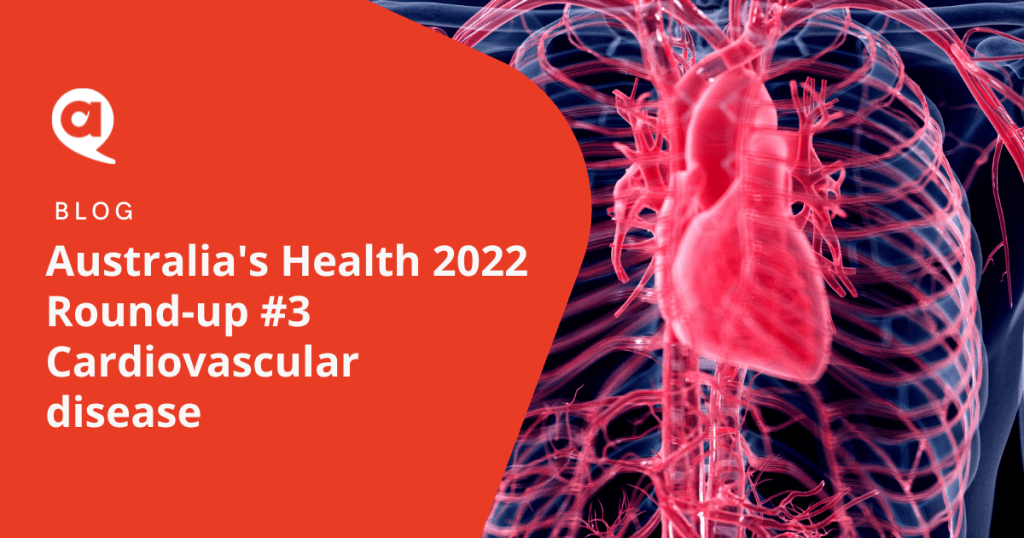
March 2023
Last year, the Australian Institute of Health and Welfare (AIHW) released Australia’s Health 2022. ACHPER NSW has compiled a series of top-level highlights with teaching notes. Round-up #3 below looks at the latest trends for Cardiovascular disease.
Previous round-ups:
Nature of Cardiovascular disease
Source: Heart, stroke & vascular diseases (AIHW)
Cardiovascular disease or CVD is a broad term that describes the many different diseases and conditions that affect the heart and blood vessels. Common types of CVD in Australia include coronary heart disease, stroke and heart failure.
Atherosclerosis – a condition where deposits of fat, cholesterol and other substances build up in the inner lining of the arteries to form plaque. Atherosclerosis can reduce or block blood supply to the heart (causing angina or heart attack) or to the brain (causing stroke). The process leading to atherosclerosis is slow and complex, often starting early in life and progressing with age.
Coronary heart disease – also known as ischaemic heart disease, is the most common cardiovascular disease. There are 2 main clinical forms:
- Heart attack – or acute myocardial infarction (AMI) – is a life-threatening event that occurs when a blood vessel supplying the heart is suddenly blocked, threatening to damage the heart muscle and its functions.
- Angina – chest pain caused by reduced blood flow to the heart.
Stroke – occurs when a blood vessel supplying blood to the brain either suddenly becomes blocked (ischaemic stroke) or ruptures and begins to bleed (haemorrhagic stroke).
Peripheral arterial disease – also known as peripheral vascular disease, is the reduced circulation of blood to a body part outside of the heart or brain. It occurs most commonly in the arteries leading to the legs and feet.
Hypertensive disease – occurs when high blood pressure is severe or prolonged enough to cause damage to the heart or other organs. It can lead to coronary heart disease, heart failure and cardiomyopathy, stroke and chronic kidney disease.
Teacher note:
Past HSC multiple choice questions have expected students to know the different terms associated with CVD e.g. peripheral vascular disease.
Extent of the problem
Sources: Heart, stroke and vascular disease: Australian facts (AIHW)
Heart, stroke and vascular disease: Australia facts – all heart, stroke and vascular disease (AIHW)
An estimated 1.2 million Australians aged 18 and over (6.2% of the adult population) had 1 or more conditions related to heart, stroke or vascular disease, based on self-reported data from the ABS 2017–18 National Health Survey.
CVD was the second leading cause of death group in 2019 behind cancers (29% of all deaths), but ahead of diseases of the respiratory system (9.7%), external causes (6.9%), and mental and behavioural disorders (6.6%).
Where CVD was listed as the underlying cause of death in 2019:
- 42% were due to coronary heart disease
- 20% were due to stroke
- 11% were due to heart failure and cardiomyopathy
- 5.2% were due to atrial fibrillation
- 5.1% were due to hypertensive disease
- 4.6% were due to peripheral arterial disease
- 0.9% were due to rheumatic heart disease.
General trends – Cardiovascular disease (CVD)
Source: Heart, stroke and vascular disease: Australian facts – all heart, stroke and vascular disease (AIHW)
CVD mortality
- Since 1960s the CVD death rate has declined substantially.
- The gap between males and females has narrowed.
- Between 1980 – 2019 the number of CVD deaths declined by 25%.
- CVD death rates have fallen for all age groups in Australia, the rate of decline in younger age groups has slowed in recent decades (AIHW 2017).
Teaching note: Reasons for decline in death rates
The large fall represents a public health success, which can be attributed to both prevention and treatment—a combination of reductions in risk factor levels, clinical research, improvements in detection and secondary prevention, and advances in treatment and care (AIHW 2017).
CVD morbidity
- An estimated 1.2 million Australians aged 18 and over (6.2% of the adult population) had 1 or more conditions related to heart, stroke or vascular disease, based on self-reported data from the ABS 2017–18 National Health Survey.
- In 2017–18, based on self-reported data, the prevalence of heart, stroke and vascular disease among adults:
- was higher among men (641,000, an age-standardised rate of 6.5%) than women (509,000, an age-standardised rate of 4.8%)
- increased with age—more than 1 in 4 (26%) of persons aged 75 and over had heart, stroke and vascular disease.
Current trends – Coronary Heart Disease (CHD)
Source: Heart, stroke and vascular disease: Australian facts – Coronary Heart Disease (AIHW)
CHD mortality
- In 2020, CHD was the leading single cause of death in Australia, accounting for 16,600 deaths (AIHW 2022c)
- CHD death rate has fallen by more than 80% since 1980 – from 414 to 68 deaths per 100,000 population for males, and 209 to 32 per 100,000 population for females
Teaching note: Reasons for decline in death rates
The decline in CHD death rates has been attributed to a combination of factors, including reductions in some risk factor levels, better treatment and care, and improved secondary prevention (ABS 2018; AIHW 2021c).
CHD morbidity
- In 2020–21, an estimated 571,000 Australians aged 18 and over (2.9% of the adult population) had CHD, based on self-reported data from the Australian Bureau of Statistics 2020–21 National Health Survey.
- The prevalence of CHD increases rapidly with age, affecting around 1 in 9 (11%) adults aged 75 and over.
- The age-standardised rate of acute coronary events fell by more than half (59%) between 2001 and 2020 (from 675 to 277 per 100,000 population). The decline was slightly higher for women (63%, from 462to 172 per 100,000 population) than men (57%, from 912 to 391 per 100,000 population).
Teaching note:
Use the interactive graphs for CHD.
Current trends – Stroke
Source: Heart, stroke and vascular disease: Australian facts – Stroke (AIHW)
Stroke mortality
- Stroke was one of the 5 leading causes of death in Australia – on average, 22 Australians died of stroke each day in 2020.
- Rates of death increase with age – in 2020, rates among males and females aged 85 and over (690 and 900 per 100,000 population) were 4–5 times as high as rates among males and females aged 75–84 years (175 and 165 per 100,000 population).
- Between 1980 and 2020, death rates for stroke have fallen by three-quarters – from 110 to 23 per 100,000 population for males, and from 99 to 24 per 100,000 population for females. The rate of decline has remained steady in people aged 75 and over but has slowed among younger age groups .
Teaching note: Reasons for decline in death rates
Falling stroke death rates have been driven by a number of factors, including improvements in some risk factors such as lower rates of tobacco smoking, an increased use of blood pressure–lowering drugs, treatment to prevent blood clots, access to stroke units in hospitals and other advances in medical care.
Stroke morbidity
- The estimated prevalence of stroke was similar in 2003 (1.7%) and 2018 (1.3%).
- The stroke event rate fell by one quarter (27%) between 2001 and 2020, from an age-standardised rate of 169 to 124 per 100,000 population.
Teaching notes:
- Students are expected to be able to speak to the trends and be able to discuss age and gender differences.
- Analyse with students what this means in terms of the potential trends in morbidity and mortality rates and how this information links to identifying priority health issues.
Groups at risk and sociocultural, socioeconomic and environmental determinants
Source: Heart, stroke and vascular disease: Australian facts – all heart, stroke and vascular disease (AIHW)
Mortality trends
Aboriginal and Torres Strait Islander people
- In 2017–2019, there were 2,100 CVD deaths among Aboriginal and Torres Strait Islander people in jurisdictions with adequate Indigenous identification.
- After adjusting for differences in the age structure of the populations, the rate of death from CVD for Indigenous Australians was 1.8 times as high as for non-Indigenous Australians (238 and 130 deaths per 100,000 population).
- Indigenous males and females had CVD death rates 1.8 times and 1.9 times as high as non-Indigenous males and females.
Socioeconomic area
- In 2017–2019, the CVD death rate was 1.5 times as high for people living in the lowest socioeconomic areas compared with those in the highest socioeconomic areas (age-standardised rates of 158 and 106 per 100,000 population).
- This difference was greater for males (1.6 times as high) than females (1.4 times as high) (Figure 10).
Remoteness area
- In 2017–2019, the CVD death rate in Remote and very remote areas was 1.4 times as high as in major cities (age-standardised rates of 172 and 124 per 100,000 population).
- The difference was similar for males and females.
Morbidity trends
Socioeconomic area
- After adjusting for different population age structures, the prevalence of heart, stroke and vascular disease did not vary significantly between adults living in the most and least disadvantaged socioeconomic areas in 2017–18 (6.4% and 4.8%).
Remoteness area
- After adjusting for different population age structures, the prevalence of heart, stroke and vascular disease among adults did not vary significantly by remoteness area in 2017–18 (5.6% in Major cities, 6.0% in Inner regional, 5.1% in Outer regional and remote).
Teaching note:
The following information provides interesting discussion around the reasons why environmental determinants have an impact on CVD rates and reasons for Identifying Priority Health Issues.


